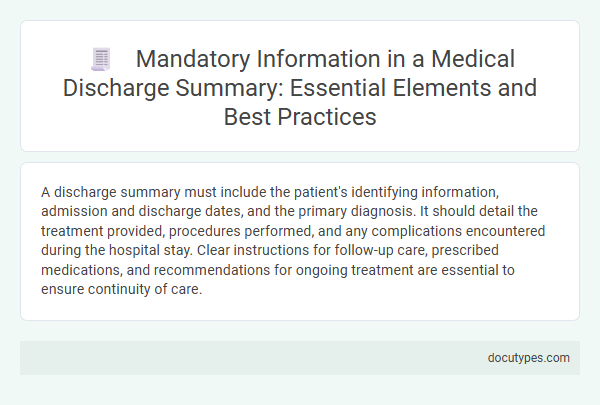A discharge summary must include the patient's identifying information, admission and discharge dates, and the primary diagnosis. It should detail the treatment provided, procedures performed, and any complications encountered during the hospital stay. Clear instructions for follow-up care, prescribed medications, and recommendations for ongoing treatment are essential to ensure continuity of care.
Introduction to Medical Discharge Summaries
A medical discharge summary is a concise document that outlines a patient's hospital stay, treatment, and instructions for follow-up care. It serves as a critical communication tool between healthcare providers and ensures continuity of care after discharge.
Mandatory information in a discharge summary includes patient identification, admission and discharge dates, diagnosis, and details of treatments provided. You should also find medication prescriptions, follow-up plans, and any instructions for ongoing care or warning signs to watch for.
Importance of Mandatory Information in Discharge Summaries
Discharge summaries serve as essential documents that ensure continuity of care by providing critical patient information to healthcare providers. Including mandatory information in discharge summaries reduces the risk of medical errors and facilitates efficient post-discharge management.
- Patient Identification Details - Accurate identification including name, age, and hospital ID ensures correct patient tracking and prevents confusion between cases.
- Diagnosis and Treatment Summary - Clear documentation of the primary diagnosis, procedures performed, and treatments administered supports ongoing clinical decisions.
- Medication Instructions - Detailed discharge medication lists and dosage guidelines prevent adverse drug events and support patient adherence to therapy.
Patient Identification and Demographic Details
| Mandatory Information in a Discharge Summary | |
|---|---|
| Patient Identification | Accurate patient identification is crucial to avoid errors and ensure continuity of care. The discharge summary must include the patient's full name, unique medical record number (MRN), date of birth, and gender. This information links the summary to the correct individual and prevents mix-ups in medical records. |
| Demographic Details | Your discharge summary should contain comprehensive demographic details such as residential address, contact number, and emergency contact information. These details facilitate follow-up care, enable communication between healthcare providers, and support patient tracking. Including ethnicity or language preferences can also enhance personalized care and support culturally sensitive practices. |
Diagnosis and Clinical Course Overview
What information is mandatory in a discharge summary regarding diagnosis and clinical course overview? The discharge summary must clearly state the primary and secondary diagnoses using standardized medical terminology. You should find a detailed account of the patient's clinical course, including treatments, procedures, and significant changes during the hospital stay.
Hospitalization Dates and Encounter Details
Hospitalization dates and encounter details are critical components of a discharge summary. Accurate documentation ensures continuity of care and supports clinical decision-making.
- Admission Date - Specifies the exact date the patient was admitted to the hospital, marking the start of the inpatient care period.
- Discharge Date - Indicates the date the patient was formally released from the hospital, signifying the end of hospitalization.
- Encounter Type - Details the nature of the hospital visit, such as inpatient, outpatient, emergency, or observation status.
Complete and precise hospitalization dates and encounter data improve patient safety and streamline care transitions.
Treatment Provided and Key Interventions
A discharge summary must include detailed information about the treatment provided during the patient's hospital stay, outlining medications administered, surgical procedures, and therapeutic interventions. Key interventions should be clearly documented to ensure continuity of care, highlighting critical actions taken to stabilize and improve the patient's condition. You will find this information essential for understanding the care received and for guiding follow-up treatment plans.
Discharge Medications and Prescriptions
A discharge summary must include detailed information about discharge medications and prescriptions to ensure safe and effective continued care. You should receive clear instructions regarding any new or ongoing medications upon leaving the healthcare facility.
- Medication Name and Dosage - Precise identification of each medication including strength and amount to avoid errors.
- Administration Instructions - Clear guidance on how and when to take each medication helps maintain proper treatment adherence.
- Prescription Duration and Refills - Information about the length of therapy and availability of refills supports ongoing medication management.
Follow-Up Care Instructions and Appointments
Follow-up care instructions in a discharge summary must clearly outline the necessary steps the patient needs to take after leaving the hospital to ensure proper recovery and avoid complications. Specific details about medication schedules, wound care, dietary restrictions, and activity limitations are essential. Scheduled appointments with healthcare providers, including dates, times, and contact information, must be included to facilitate continuous medical supervision.
Patient Education and Counseling Provided
Discharge summaries must include detailed information on patient education and counseling provided during the hospital stay. This ensures patients understand their diagnosis, treatment plan, medication regimen, and any necessary lifestyle modifications.
Clear documentation of educational topics covered helps improve patient compliance and reduces the risk of readmission. It also supports continuity of care by informing primary care providers about instructions given to the patient.
What Information is Mandatory in a Discharge Summary? Infographic

